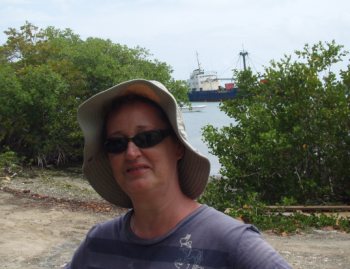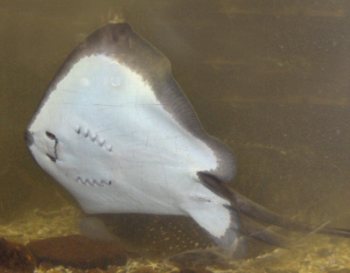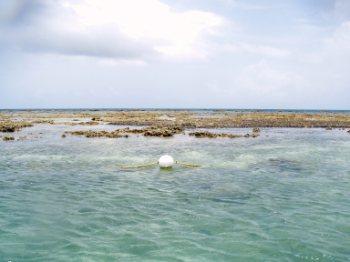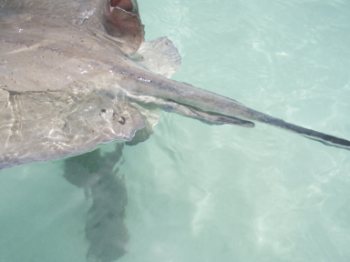|
Stingrays
Up we jumped, breakfasted, on the
road by 09:45 for the forty-five minute drive to Seatons, we arrived in plenty
of time for the arranged 10:45 briefing, swim with the Stingrays at
11:00.
As Jump was doing an impression of a
red-knee frog, plenty of 80
factor was slathered on. All ready for the off
complete with hat.
At 11:00 the three of us and a German
couple celebrating their 25th Wedding Anniversary were sped across the lagoon.
Hat back in the wind then flopped to show the detail
- 'Jump Jet - not to be trusted' - a reference to her
inability to add sun block unless severely nagged. Strange really when that
someone has to apply 80 factor and still get burnt bits.
We had our lesson
in holding these beautiful creatures.
Bear and Jump
having fun, but look at just how many rays are behind
them. The important thing for us was these Stingrays have the freedom to
come and go as they please. The lads at Stingray City have come out at
10:00, 11:00 and 13:00 each and every day for the last seven years - that's 365
days a year, whether there are tourists or not. They have no control over how
many appear for feeding. We had to sign waivers as part of our briefing and it
is clearly pointed out that the rays are wild. They just happen to like the
regular feeding of squid, saving them much floor hoovering.
There was only one boy, much smaller than the females. One of the chaps
lifted the TWO 'things' that make it a male. The eye and the
infamous barb. What we had to realise is the fact that the stingray
has no control over the barb, it just happens to be there half way along the
tail - therefore it was important for us to shuffle not step. Rays have one bone
all the way down the back through to the end of the tail.
This lady was
happy to show her flying skills whilst sneaking a hug.
Stingrays are a family, Dasyatidae of
rays, cartilaginous fishes related
to sharks. They
are common in coastal tropical marine waters throughout the world, and several
species are known to enter fresh water. Other
types of rays also referred to as "stingrays" are the river
stingrays (family
Potamotrygonidae), the
round stingrays
(families Urolophidae and
Urotrygonidae), the
sixgill stingray (family
Hexatrygonidae), and
the deepwater stingray (family
Plesiobatidae).
For clarity, the members of the family Dasyatidae are sometimes called
"whip-tail stingrays".
While most dasyatids are relatively widespread and not
currently threatened, there
are several species (for example Taeniura meyeni,
Dasyatis colarensis,
Dasyatis garouaensis, and
Dasyatis laosensis) where
the conservation status is more problematic, leading to them being listed as
vulnerable or
endangered by
IUCN. The
status of several other species are poorly known, leading to them being listed
as Data Deficient.
Stingray can be 35 feet
long.
Depending on the size of the stingray, humans are usually
stung in the foot region. It is less likely to be stung by brushing against the
stinger. Surfers and those who enter waters with large populations of stingrays
have learned to slide their feet through the sand rather than stepping, as the
rays detect this and swim away. Stamping hard on the bottom as one treads
through murky water will also cause them to swim away.

One ray decided to jump the queue at
feeding time.
Humans
who harass stingrays have been known to be stung elsewhere, sometimes leading to
fatalities. The stinger usually breaks off in the wound. This is not fatal to
the stingray as it will be regrown at a rate close to that of human fingernails
(about .5-.75 inches per month). Contact with the stinger causes local trauma
(from the cut itself), pain and swelling from the venom, and possible later
infection from bacteria. Immediate injuries to humans include, but are not
limited to: poisoning,
punctures, severed arteries,
and possibly death. Fatal stings are very rare, but can happen. In Greek
mythology, Odysseus, the great king of Ithaca, was killed when his son,
Telegonus, struck him using a spear tipped with the spine of a
stingray.
Treatment
for stings includes application of near-scalding water, which helps ease pain by
denaturing the complex venom protein, and antibiotics.
Immediate injection of a local anaesthetic in and
around the wound is very helpful, as is the use of opiates such as
intramuscular pethidine. Local
anesthetic brings almost instant relief for several hours. Any warm to hot
fluid, including urine, may provide some relief. Vinegar and
papain are
ineffective. Pain normally lasts up to 48 hours, but is most severe in the first
30–60 minutes and may be accompanied by nausea, fatigue, headaches, fever, and
chills. All stingray injuries should be medically assessed; the wound needs to
be thoroughly cleaned, and surgical exploration is often required to remove any
barb fragments remaining in the wound. Following cleaning, an
ultrasound is
helpful to confirm removal of all the fragments. Not all
remnants are radio-opaque; but x-ray radiography
imaging may be helpful where ultrasound is not
available.


This guide spent a lot of time explaining
rays to us, he was so relaxed with them, they sensed his ease and each
one he held stayed with him for ages. At any point they could just 'fly' off.
Jump having a stroke.
Reproduction: The mating season
occurs in the winter. When a male is courting a female, he will follow her
closely, biting at her pectoral disc. Most rays
are ovoviviparous, bearing live young in
"litters" of five to thirteen. The female holds the embryos in the womb without
a placenta. Instead, the embryos absorb nutrients from a yolk sac, and after the sac is depleted, the mother provides uterine
"milk".
Stingrays are usually very docile, their usual reaction
being to flee any disturbance. Nevertheless, certain larger species may be more
aggressive and should only be approached with caution by humans, as the
stingray's defensive reflex may result in serious injury or death.
Stingrays are commonly
found in the shallow coastal waters of temperate seas. They spend the majority
of their time inactive, partially buried in sand, often moving only with the
sway of the tide. The stingray's coloration commonly reflects the seafloor's
shading, camouflaging it from predatory sharks and larger rays. Their flattened
bodies are composed of pectoral fins joined to their head and trunk with an
infamous tail trailing behind.
The
eye up close, the underbelly and the fin that allows
reverse gear.
While
the stingray's eyes peer out from its dorsal side, its mouth, nostrils, and gill
slits are situated on its underbelly. Its eyes are therefore not thought by
scientists to play a considerable role in hunting. Like its shark relatives, the
stingray is outfitted with electrical sensors called ampullae of Lorenzini.
Located around the stingray's mouth, these organs sense the natural electrical
charges of potential prey. Many rays have jaw teeth to enable them to crush
molluscs such as clams, oysters and mussels.
Stingray 'in flight', digging in
to sleep after feeding, the southern rays that
we swam with.
When
they are inclined to move, most stingrays swim by undulating their bodies like a
wave; others flap their sides like wings. The tail may also be used to manoeuvre
in the water, but its primary purpose is protection.
One of
our fed ladies buried herself for a snooze to digest
her meal, they need about an hour quality zeds. They back in, wiggling as they
go until just their eyes and tail are showing, you can see how we could
accidentally step on them.
After
the rays had been fed we had time to snorkel and
explore around the reef.
A porcupine fish, crawfish and tuna.
Also
the lesser foot, lower striped end and the red
knee.
Back to
hugging our only boy who was very happy to be hugged,
stroked and lay peacefully in one of our guides arm for
ages.
Cradling these beautiful, powerful, muscular and yet
somehow soft, velvety creatures, something each of us will never
forget.
ALL IN ALL an amazing experience
- one of the most
unforgettable experiences of our trip - JJ simply
fantastic.
| 








































